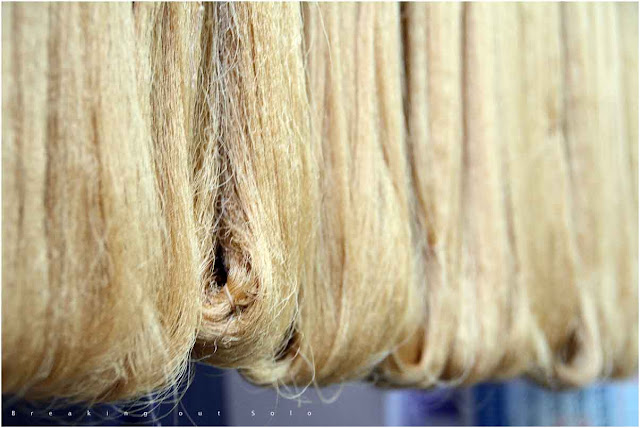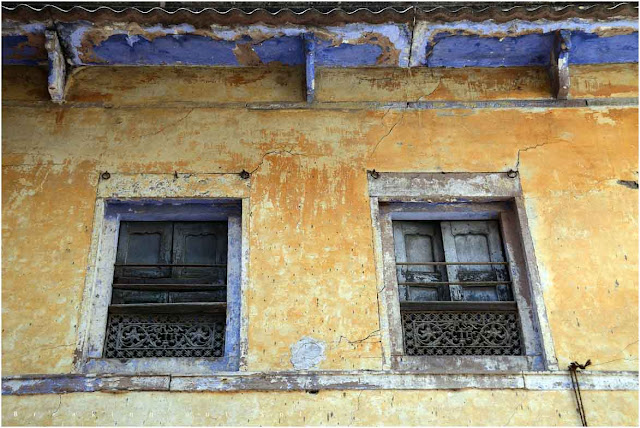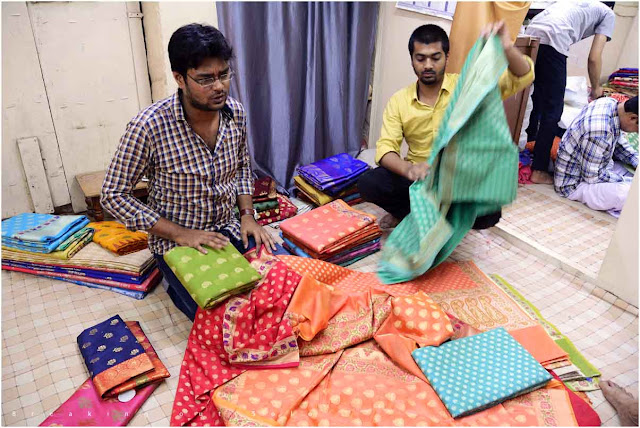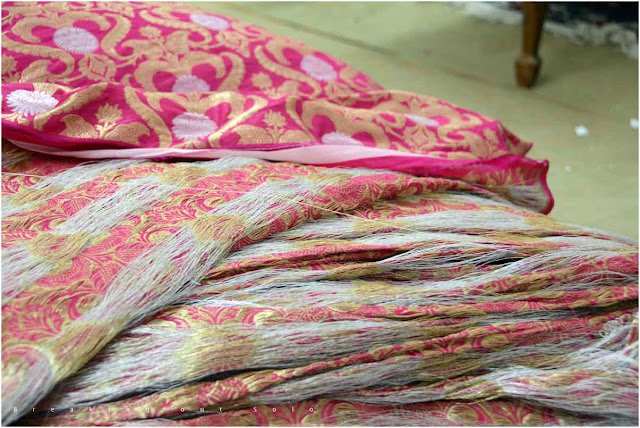Holidays have become very difficult to come by in my current work situation and adding to the woe, long weekend airfares from Hong Kong are obnoxiously pricey. Therefore, trips have to be either planned well in advance or I just have to do it over a weekend. While Cambodia was the former, Taiwan was only a weekend joy. The irony here is, this year Hong Kong had far more long weekends than any other place I have ever worked at.
So why Taiwan?
When I asked my local friends at work for an overseas weekend plan, this was their general consensus and I thought, why not. Taiwan is only a short and cheap flight away from Hong Kong. The entry formality is simple too. With my previous UK visa, I only needed to apply for an online permit at no extra cost, which I submitted on a Sunday night and had it emailed to me by Monday morning. However, when I asked my friends at work for suggestions on my visit, there wasn't much information coming by. All they said was they went there for shopping and the food. So it was left between the internet and me.
The day arrives
The journey started early on a Saturday morning. After finishing late at work on Friday, I could barely catch three hours sleep and was on the airport bus at six. During boarding, the ground crew had some confusion regarding my entry permit, but it was quickly resolved and my passport was duly handed back. The Cathay Dragon flight touched down at half nine. Nice and early, I was looking forward to a fruitful day ahead, that is, until I stood in the immigration queue. The serpentine line moved slowly, growing longer by the minute and by the time I reached the desk, it was past noon.
Formalities done, I dragged my aching legs, first stopping at the currency exchange as I needed a top-up of cash. The exchange rate was significantly better than I had got in Hong Kong. Second stop was at the MRT shop, the metro, where I purchased an Easycard. What I had gathered from the various travel forums is that the Easycard was a convenient way to travel (there are other cards as well but information was not easy to come by). However the forums were not very clear about how it worked apart from that it could be used on all public transport. So, this is what the guy told me. I had to keep a non-refundable hundred dollars on the card as I charged it with the minimum five hundred, giving me four hundred to use. I would get a 20% discount on MRT travel (though I never figured it out as I didn't know the actual price). I even noticed a 10% discount on the TRA trains when I used it the next day. Any remaining balance above the non-refundable hundred, could be refunded.
The most convenient way to get to the city is the Taoyuan Airport MRT which goes to the Taipei Main station, the central hub, the heart of Taipei's transport system. Apart from the airport MRT, Taipei Main Station also houses the city MRT, the TRA train service to other parts of Taiwan and the central bus station. My hotel was a short walk from the main station, six minutes, said Google map. For most of the forty five minutes train journey we were passing through green, hilly landscape until the city appeared in view. It was a sharp contrast.
Walking through Taipei Main station I started to realise how huge the place was. Though it is well way-marked, the only directions it didn't clearly state were the exits. Signs pointed to M1 to M8 in the beginning, however at a three point junction, it failed to mention which direction to take for M3-M8. No wonder, this was the place I have been the most lost in my two days in Taipei. After a few detours, I managed to eventually exit the station and take the right one too.
 |
| Streets of Taipei |
Earlier, while booking accommodation for Taipei, I was taken aback by the number of places that did not have any windows in the rooms and having one was actually an advertising feature. Moreover almost all had shared bathrooms. It was about price and convenience and I ended up booking the York hotel, close to the main station as I mentioned earlier.
The York hotel is divided between the basement and the 4th floor of a tightly built building. After I checked in at the fourth floor, I had to swipe an access card on the lift to select the basement. The basement opened into a common lounging area with a television and stocked with books, a couple of personal computers and a supply of refreshments for self service. The rooms were set out along a narrow cemented with exposed brick decor corridor. The room doors were of moulded aluminium sheets with room numbers painted on in large fonts. The rooms themselves were narrow rectangular boxes, in cement hue and sparsely furnished with metal furniture. Illumination was by a dim tungsten lamp. Everything in the rooms was reminiscent of the images of prison cells I have seen on television. Probably it is supposed to be trendy, but I was fighting claustrophobia. Just had to close my eyes and sleep I figured. My
Facebook post from the day has the photographs.
The bed was soft and comfortable though and the air conditioning good. The shared bathrooms, separated into male and female were very clean with hot water and hair driers.
The check-in time was at three, but the friendly staff allowed me in early.
Half a day in Taipei
It was past two when I stepped out of my room, finally starting on my Taiwan weekend. By now, I had only a day and a half. My plan was to spend the first day in Taipei. Next day I was to head over to Jiufen and Shifen, to the east of Taipei. I would sleep at the airport Sunday night and then take the early morning flight back to Hong Kong and straight to work on Monday.
There was a lot to see in Taipei itself, for which half a day was definitely not enough. However, in my recent years of travelling, I have become more of a wanderer than a sightseer, hence missing some sights did not bother me much. Moreover it keeps me wanting to return for experiencing the rest. Nowadays, it is more about appreciating the culture, absorb the atmosphere rather than be a tourist. I have been travelling without internet most of my time, only the occasional free WiFi in certain locations to put me back on track. This time I had downloaded the offline Google map of Taipei on my phone for reference, though I still had my preferred physical map collected at the hotel. A pre-visit look at the map gives a rough idea of the area I would visit. After that I follow the road signs and wander, asking the locals when I am lost. It normally works for me, losing my way and thereby finding something new.
 |
| 228 Peace Memorial Park |
As I walked on to the street, I noticed a beautiful spot of greenery at the junction to my left and decided to take a look before heading to the MRT station in the opposite direction. The greenery turned out to be the 228 Peace Memorial Park, built in memory of the victims of 28th February 1947, housing a memorial, traditional Chinese structures and fountains. As I was reading about Taiwan's history of struggle on the display boards, someone was playing a melancholy tune on a flute. The ambience was sombre, a moment for reflection. It felt like a perfect way to start my visit of Taiwan.
 |
| Watermelons in abundance |
 |
| Random street shot |
 |
| Contrast within the city |
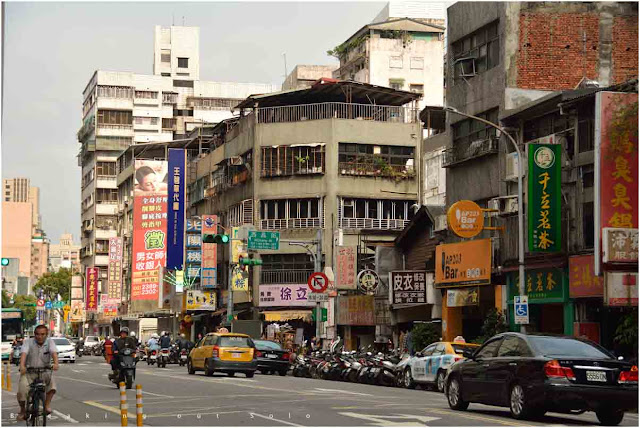 |
| Streets of Taipei |
On the MRT, my first stop was the Longshan temple. The hotel receptionist had mentioned that people came here to pray for love. The temple was busy, mainly with mobile wielding young people taking selfies and praying, not at the same time though thankfully. Built in early eighteenth century, the temple is an impressive and beautiful structure. It had been badly damaged during the second world war by American bombers who suspected Japanese troops of taking shelter within. Since then it has been repaired and renovated.
 |
| Longshan Temple entrance |
 |
| Inside Longshan temple |
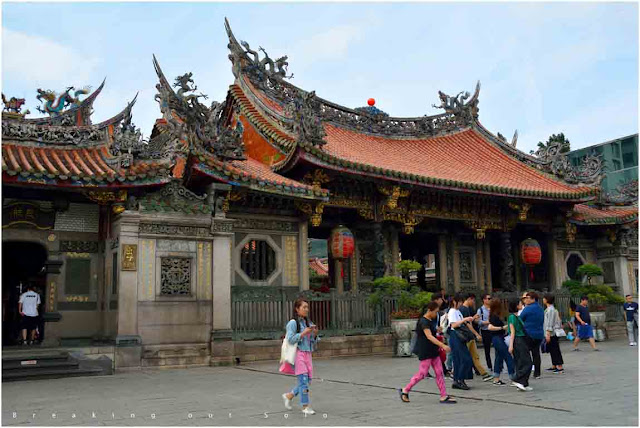 |
| Longshan temple courtyard |
 |
| A taxi goes past the Longshan temple |
Exiting the temple, street signs pointed towards the Qingshan temple and the night markets. I made a mental map and headed for the temple first. The over a century old Qinshan is another impressive temple in Taipei, but much quieter than Longshan. I spent some time in its tranquil atmosphere, taking photographs.
 |
| Qinshan temple entrance |
 |
| Qinshan temple courtyard |
 |
| Qinshan temple ceiling details |
It was time to wander off again. This is when I spotted the shop selling tea leaves and had a unique experience with a passionate tea seller, of which I wrote about a few days ago on one of my posts. You can read about it
here.
So, armed with my recent purchase of Oolong tea, my next stop was the Huaxi Street Night Market. It was late afternoon and the shops were still mostly closed, a few gearing up for the evening. Snake soup is a delicacy in this part of Taipei, but I didn't spot any shops selling them. My friends in Hong Kong had told me that winter is the best time for snake soup, probably the reason I didn't see much advertised. I spotted a shop selling the famed Taiwanese baked pork buns topped with sesame seeds and stopped for a photo. The owner wanted me to buy one. He asked with such warm friendliness that I could not refuse. This friendliness of the locals had been a recurring theme in Taiwan, a welcome change after Hong Kong. As he packed my order, I couldn't help noticing the group of people sitting in his shop, people from all ages, probably his family, chatting. This was true for many of the shops I passed, locals, possibly friends and family sitting together, chatting over food and tea, spending quality time before the tourists hit in the evenings. I felt homesick.
 |
| Huaxi night market gate |
 |
| Inside Huaxi night market |
 |
| Baked pork buns at a street shop with people sitting around |
The bun was filled with pork and spring onions and baked in the oven. At forty Taiwanese dollars, it is a cheap and filling snack.
From the Huaxi Night Market I walked straight into the Guangzhou Street Night Market. This street had started to gather more activities than the former. Needless to say, it was all about food too.
 |
| In preparation for the night |
 |
| Guangzhou street night market |
 |
| Life revolves around food |
 |
| Some kind of filled pastry with a variety of choices |
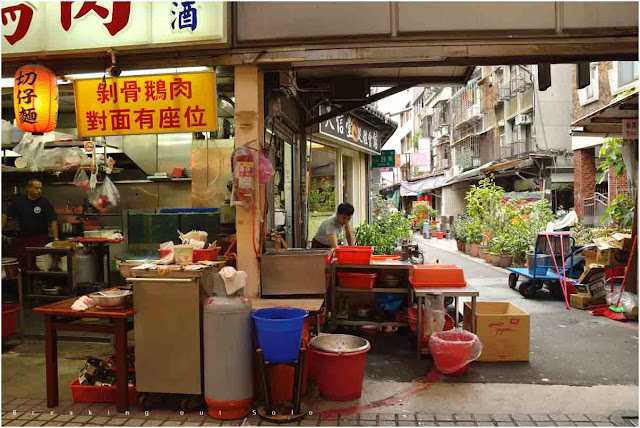 |
| Vendors in preparation for the night |
Walking back to the MRT, a well aged man was standing in front of me at the pedestrian lights. I noticed the price tag from his obvious new T-shirt, hanging out from his collar on to his back. I touched his arm to get his attention and tried to explain it to him. He understood despite not speaking any English. and gestured if I could take it off. I managed after some effort. He thanked me and I walked away. But then I heard him frantically calling out. I looked back and he was waving his hands at me as he wobbled over. He was holding out a slice of apple, cleanly peeled to suite his old teeth or lack of it. I declined, but he was not letting me go either without it. I had to accept it, was touched by his warmth.
Bright souvenir shops lined the premises outside the MRT and I spent some time browsing through them before buying a painted ceramic tea cup. As I was casually browsing past a jewellery shop, the owner asked me in and offered me tea. He refused to take a no, so I settled for some water. I told him outright that I did not have the money to make a purchase from his shop. But he wanted me to have a seat, so I did as he talked about Taiwan, the changing times, his business and went on to ask me about India once I told him where I was from.
 |
| Souvenir shops |
 |
| Brightly coloured traditional Chinese merchandise |
From Longshan, I was heading to the centre, to Taipei 101. Built in 2004 replicating the looks of a bamboo tree, the 101 floor structure had been the highest building in the world for six years, between the Petronas Tower in Kuala Lumpur and the Burj Khalifa in Dubai. The observatory inside the tower can be accessed by Guinness World Record breaking high-speed elevators, of course for an entrance fee, for a birds eye view around the city. My plan was to first go see the Taipei 101 up close and then head to a different view point, the Elephant mountain or Xiangshan. This hill, standing at 600 feet, is the most accessible of the four beast hills of Taipei, all situated around the area. The other three are called Leopard Mountain or Baoshan, Lion Mountain or Shishan and Tiger Mountain or Hushan. However, by mistake, instead of taking the MRT to Taipei World Trade Centre, I ended up at Taipei City Hall and had to walk the two kilometres or so to Taipei 101.
 |
| Taipei 101 close-up |
The stairs up the Elephant Mountain gets quite steep towards the top. I had read that the place gets very busy during sunset, especially on weekends, but I did not realise how busy it would really be. The view points were packed and it was difficult to find a clear view as people armed with photographic equipment ranging from mobile phones to professional cameras perched at every possible nook and corner with a view. I managed to squeeze in a few shots. Fortunately I found a quieter spot higher up and spent some time taking in the views of Taipei at night.
It was dark by the time I was coming down and though the lights did a decent job, the shadows still danced around. I struggled walking down the steep stairs. Thankfully for most part of the trail, there was a handrail. It was my lifeline.
 |
| Taipei night view from Xianshan |
My last stop for the night was Shilin Night Market. I walked down to the Xianshan MRT for the journey back this time. Taipei 101 was dazzling in blue not too far away. The heat and the walk had made me thirsty. I fished out my water bottle from my bag and had barely taken a sip when I heard screaming from up the stairs. I looked up and saw an MRT staff waving furiously at me gesturing me to put the bottle back. I obliged as she came running down the stairs and started telling me off in Mandarin. 'No food or drink' she finally said in English. I remembered it's the same rule in Hong Kong, but I was dying of thirst. I could only say 'Sorry' and she left.
Jiantan was my stop for the night market and this time I was at the correct stop. Off the train, I started following the crowd. Shilin is the most popular of the night markets in Taipei, especially for the tourists. On a Saturday evening, the streets are practically impassable.
The market was an assault on the senses, both visual and olfactory. The air was heavy with the whiff of stinky tofu, which despite its popularity, I refused to try. Tofu isn't my favourite food and I didn't find the smell inviting either. Food and other merchandise vied for space in the narrow crowded lanes. After being through two under prepared night markets earlier in the day, it was only now I realised what a night market truly felt like. Food ranged from the traditional Chinese ones I was already familiar with in Hong Kong, to the Taiwanese and then the very groovy ones. I tried out the crushed ice, but crunching on a big bowl of ice with flavours of red bean and fruity taro balls didn't do much for me.
 |
| Shilin night market |
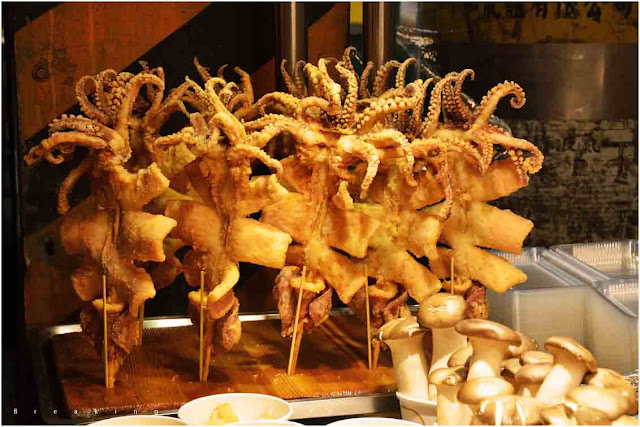 |
| Deep fried cuttlefish or perhaps squid |
I bought some bite size Taiwanese sausage, made my payment and started walking away happily chomping on them when the vendor started calling me back. Saw him scrambling in his money box and I started wondering if I had made a mistake with the payment. He held up his hand momentarily asking me to wait as he kept searching, Eventually he found what he was looking for and held out a greasy note to me. Confused I unfolded it. It was an Indian ten rupees note! Seeing my surprise, he smiled and signalled me to keep it. I wondered if someone had fooled him by paying in a wrong currency, but was impressed since he was the first person throughout my stay and travels in Hong Kong, Macau or Taiwan who had figured out that I was an Indian without being told.
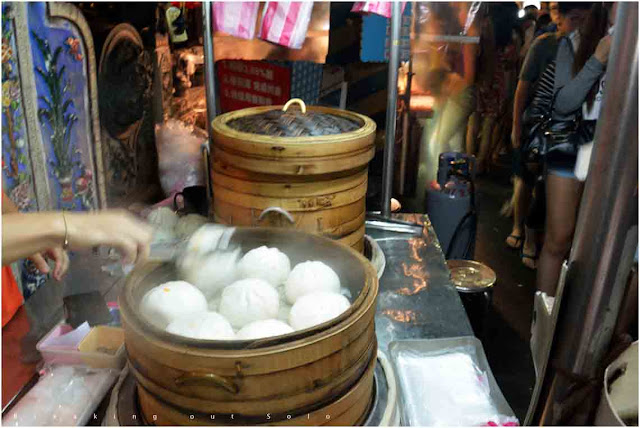 |
| Steamed buns - by now I was too full to try them |
 |
| In preparation of being grilled |
 |
| Shilin market delicacies |
 |
| Dumplings |
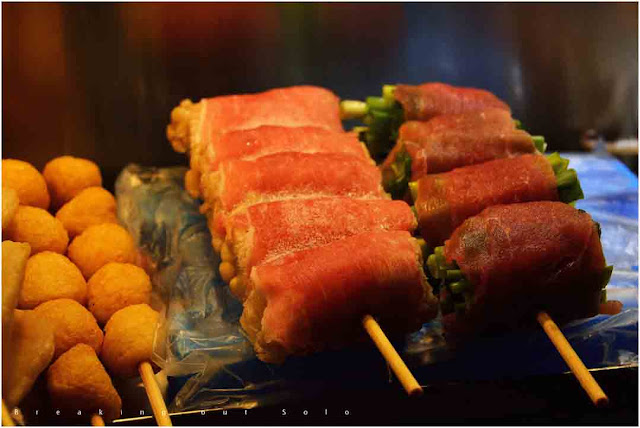 |
| Veggies wrapped in pork, a Taiwanese food invention |
 |
| Sausages - really big ones |
It was about ten and I decided to call and end to my first day in Taipei. The lack of sleep from the previous night was taking its toll and I was craving for bed. After another adventure at the Taipei Main Station, I eventually found the exit.
Back at the hotel, a hot shower, and I hit bed. Closing my eyes indeed helped with both the claustrophobic feeling and my sleep. Next morning I was heading out to Jiufen. I intended it to be an early start.
For more stories and photographs from the trip, follow me on
Facebook and
Instagram

